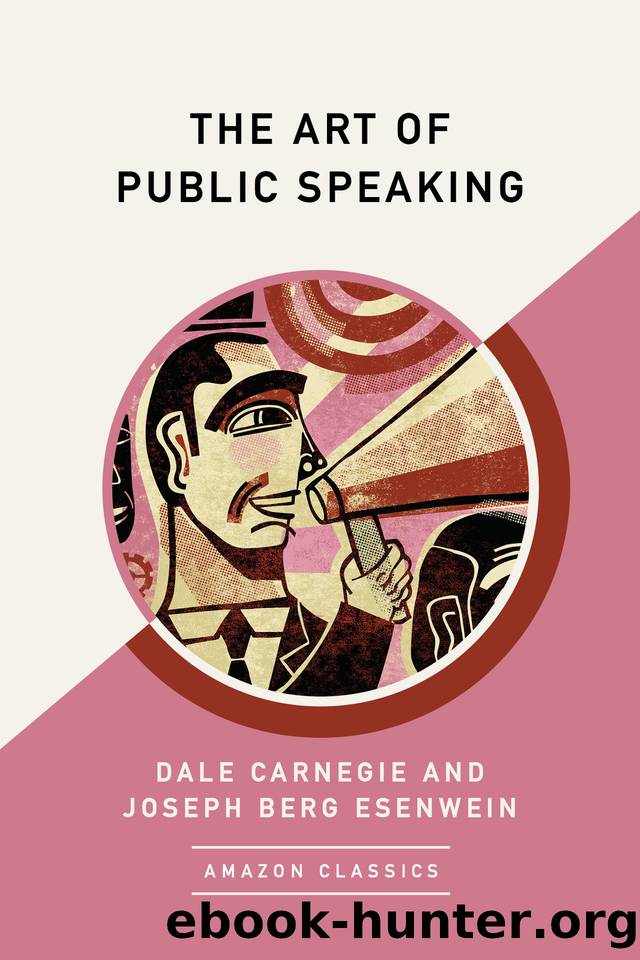The Art of Public Speaking by Dale Carnegie & Joseph Berg Esenwein

Author:Dale Carnegie & Joseph Berg Esenwein [Carnegie, Dale & Esenwein, Joseph Berg]
Language: eng
Format: epub
Publisher: Amazon Classics
Published: 2018-04-23T18:30:00+00:00
CHAPTER 25
Influencing the Crowd
Success in business, in the last analysis, turns upon touching the imagination of crowds. The reason that preachers in this present generation are less successful in getting people to want goodness than business men are in getting them to want motorcars, hats, and pianolas, is that business men as a class are more close and desperate students of human nature, and have boned down harder to the art of touching the imaginations of the crowds.
âGerald Stanley Lee, Crowds.
In the early part of July, 1914, a collection of Frenchmen in Paris, or Germans in Berlin, was not a crowd in a psychological sense. Each individual had his own special interests and needs, and there was no powerful common idea to unify them. A group then represented only a collection of individuals. A month later, any collection of Frenchmen or Germans formed a crowd: Patriotism, hate, a common fear, a pervasive grief, had unified the individuals.
The psychology of the crowd is far different from the psychology of the personal members that compose it. The crowd is a distinct entity. Individuals restrain and subdue many of their impulses at the dictates of reason. The crowd never reasons. It only feels. As persons there is a sense of responsibility attached to our actions which checks many of our incitements, but the sense of responsibility is lost in the crowd because of its numbers. The crowd is exceedingly suggestible and will act upon the wildest and most extreme ideas. The crowd-mind is primitive and will cheer plans and perform actions which its members would utterly repudiate.
A mob is only a highly-wrought crowd. Ruskinâs description is fitting: âYou can talk a mob into anything; its feelings may beâusually areâon the whole, generous and right, but it has no foundation for them, no hold of them. You may tease or tickle it into anything at your pleasure. It thinks by infection, for the most part, catching an opinion like a cold, and there is nothing so little that it will not roar itself wild about, when the fit is on, nothing so great but it will forget in an hour when the fit is past.â28
History will show us how the crowd-mind works. The medieval mind was not given to reasoning; the medieval man attached great weight to the utterance of authority; his religion touched chiefly the emotions. These conditions provided a rich soil for the propagation of the crowd-mind when, in the eleventh century, flagellation, a voluntary self-scourging, was preached by the monks. Substituting flagellation for reciting penitential psalms was advocated by the reformers. A scale was drawn up, making one thousand strokes equivalent to ten psalms, or fifteen thousand to the entire psalter. This craze spread by leapsâand crowds. Flagellant fraternities sprang up. Priests carrying banners led through the streets great processions reciting prayers and whipping their bloody bodies with leathern thongs fitted with four iron points. Pope Clement denounced this practise and several of the leaders of these processions had to be burned at the stake before the frenzy could be uprooted.
Download
This site does not store any files on its server. We only index and link to content provided by other sites. Please contact the content providers to delete copyright contents if any and email us, we'll remove relevant links or contents immediately.
| Advertising | Consumer Behavior |
| Customer Service | Marketing |
| Public Relations | Sales & Selling |
| Search Engine Optimization |
Influence: The Psychology of Persuasion by Robert B. Cialdini(4199)
The Miracle Morning by Hal Elrod(3933)
The Hacking of the American Mind by Robert H. Lustig(3597)
Pre-Suasion: A Revolutionary Way to Influence and Persuade by Robert Cialdini(3437)
Unlabel: Selling You Without Selling Out by Marc Ecko(3001)
Hidden Persuasion: 33 psychological influence techniques in advertising by Marc Andrews & Matthijs van Leeuwen & Rick van Baaren(2801)
Who Can You Trust? by Rachel Botsman(2739)
Kick Ass in College: Highest Rated "How to Study in College" Book | 77 Ninja Study Skills Tips and Career Strategies | Motivational for College Students: A Guerrilla Guide to College Success by Fox Gunnar(2727)
Purple Cow by Seth Godin(2712)
Ogilvy on Advertising by David Ogilvy(2709)
I Live in the Future & Here's How It Works by Nick Bilton(2539)
This Is Marketing by Seth Godin(2504)
The Marketing Plan Handbook: Develop Big-Picture Marketing Plans for Pennies on the Dollar by Robert W. Bly(2428)
The Power of Broke by Daymond John(2391)
Building a StoryBrand by Donald Miller(2378)
The 46 Rules of Genius: An Innovator's Guide to Creativity (Voices That Matter) by Marty Neumeier(2322)
Draw to Win: A Crash Course on How to Lead, Sell, and Innovate With Your Visual Mind by Dan Roam(2286)
The Tipping Point by Malcolm Gladwell(2214)
Market Wizards by Jack D. Schwager(2177)
